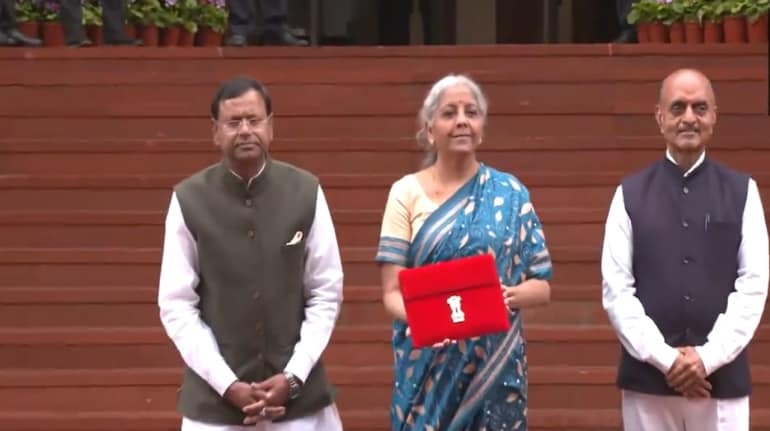The Indian stock market is expected to open flat as the Nifty futures were trading at 15,747 on the Singaporean Exchange.
The BSE Sensex fell 66.95 points to 52,482.71, while the Nifty50 declined 27 points to 15,721.50 and formed a bearish candle which resembles an Inverted Hammer kind of pattern on the daily charts.
According to pivot charts, the key support levels for the Nifty are placed at 15,673.83, followed by 15,626.17. If the index moves up, the key resistance levels to watch out for are 15,804.13 and 15,886.77.
Stay tuned to Moneycontrol to find out what happens in the currency and equity markets today. We have collated a list of important headlines across news platforms which could impact Indian as well as international markets:
US Markets
The S&P 500 nabbed its fifth straight record closing high on Wednesday as investors ended the month and the quarter by largely shrugging off positive economic data and looking toward Friday’s highly anticipated employment report.
The Dow Jones Industrial Average rose 210.22 points, or 0.61%, to 34,502.51, the S&P 500 gained 5.7 points, or 0.13%, to 4,297.5 and the Nasdaq Composite dropped 24.38 points, or 0.17%, to 14,503.95.
Asian Markets
Shares in Asia-Pacific slipped in Thursday morning trade as investors reacted to the release of Chinese economic data. Nikkei 225 shed 0.39% while the Topix index fell 0.32%.
SGX Nifty
Trends on SGX Nifty indicate a cautious opening for the index in India. The Nifty futures were trading at 15,747 on the Singaporean Exchange around 07:30 hours IST.
Centre's April-May fiscal deficit comes in at 8.2% of full year target
The centre's fiscal deficit for the first two months (April-May) of 2021-22 came in at Rs 1.23 lakh crore, or 8.2 percent of the full year target of Rs 15.07 lakh crore, data released by the Controller General of Accounts showed on June 30.
The fiscal deficit for the same period last year had reached 58.6 percent of the full year target. That was in the middle of the nationwide lockdown, when the centre's revenues had all but dried up due to lack of economic activity, and expenditure commitments had increased.
The centre's net tax revenue for April-May 2021 was Rs 2.33 lakh crore, or 15 percent of the full year budget estimates, compared with just two percent for the same period last year.
SEBI gives more time to brokers, clearing members to comply with rules
Markets regulator SEBI on Wednesday extended deadlines for complying with certain regulatory requirements by stock brokers, clearing members and KYC registration agencies in view of the ongoing COVID-19 pandemic.
The deadline for maintaining call recordings of orders or instructions received from clients has been extended by one month till July 31, the Securities and Exchange Board of India (SEBI) said in a circular. Also, the regulator has given time till July-end to brokers for operating the trading terminals from designated alternate locations.
China June factory growth slows on COVID-19, supply chain snags - Caixin PMI
China’s factory activity expanded at a softer pace in June, as the resurgence of COVID-19 cases in the export province of Guangdong and supply chain woes drove output growth to the lowest in 15 months, a private survey showed on Thursday.
The Caixin/Markit Manufacturing Purchasing Managers’ Index (PMI) fell to 51.3 last month from May’s 52, marking the 14th month of expansion, but it came below analyst expectations for a only slight slowdown to 51.8.
U.S. private payrolls increase solidly; pending home sales rebound
U.S. private payrolls increased more than expected in June as companies rushed to boost production and services amid a rapidly reopening economy, though a shortage of willing workers continues to hang over the labour market recovery.
Private payrolls increased by 692,000 jobs in June. Data for May was revised lower to show 886,000 jobs added instead of the initially reported 978,000. Economists polled by Reuters had forecast private payrolls would increase by 600,000 jobs.
Japan business mood at 2.5-year high as COVID hit eases
Japanese big manufacturers’ business confidence improved in the second quarter to hit a two-and-half-year high, a central bank survey showed, a sign solid global demand was helping the economy emerge from the coronavirus pandemic-induced doldrums.
Service-sector sentiment also turned positive for the first time in five quarters, the Bank of Japan’s (BOJ) “Tankan” survey showed, indicating that the economic recovery was broadening even as Japan struggles to contain a fresh wave of coronavirus infections.
FII and DII data
Foreign institutional investors (FIIs) net sold shares worth Rs 1,646.66 crore, while domestic institutional investors (DIIs) net purchased shares worth Rs 1,520.18 crore in the Indian equity market on June 30, as per provisional data available on the NSE.
Stocks under F&O ban on NSE
One stock - NALCO - is under the F&O ban for July 1. Securities in the ban period under the F&O segment include companies in which the security has crossed 95 percent of the market-wide position limit.
With inputs from Reuters & other agencies
Adblock test (Why?)
Top 10 things to know before the market opens - Moneycontrol.com
Read More























